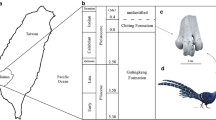Abstract
The Yuanmou Basin of Yunnan Province is a hotspot for the research of early hominid evolution and its environmental background. During the implementation of the Program “Research of the Origin and Evolution of Early Man and Its Environmental Background” from 1998 to 2001, a huge quantity of hominoid and mammal fossils were collected. The present report systematically describes anEuprox robustus sp. nov. identified during the recent laboratory work on the collected material.Euprox is a group of earliest cervids with true antlers. The new species is the third one of the genus discovered in China. Judged by its morphologic characteristics, the new species feed on juicy and tender leaves of dicotyledon. It implies that the vegetation of its epoch in the Yuanmou Basin is a kind of southern subtropical evergreen forest and the climate is humid and temperate with evident seasonality. The latter is mostly influenced by the monsoon and secondly by the latitude.
Similar content being viewed by others
References
Qian, F., On the age of “Yuanmou Man” — A discussion with Liu Tungsheng et al., Acta Anthropologica Sinica (in Chinese), 1985, 4(4): 324–332.
He, Z. Q. (ed.), Yuanmou Hominoid Fauna (in Chinese), Kunming: Yunnan Science & Technology Press, 1997, 1–270.
Zdansky, O., Fossile Hirsche Chinas, Palaeontologica Sinica, 1925, C, 2(3): 1–94.
Colbert, E. H., Some cervid teeth from the Tung Gur Formation of Mongolia, and additional notes on the genera Stephanocemas and Lagomeryx, American Museum Novitates, 1940, 1062: 1–6.
Vislobokova, I. A., The Fossil Deer of Eurasia, Moscow: Sciences Press, 1990, 1–208.
Heintz, E., Les Cervides villafranchiens de France et d’Espagne, Mémoire du Muséum National d’Histoire Naturelle, 1970, 22(2): 1–206.
Janis, C. M., Scott, K. M., The interrelationships of higher ruminant families, with special emphasis on the members of the Cervoidea, American Museum Novitates, 1987, 2893: 1–85.
Dong, W., A morphological analysis of cheek teeth of Eurasian Pliocene cervids, Deer of China (eds. Ohtaishi, N., Sheng, H. L.), Amsterdam: Elsevier Science Publishers B V, 1993, 65–72.
Pan, Y. R., Artiodactyla, Yuanmou Hominoid Fauna (ed. He, Z. Q.) (in Chinese), Kunming: Yunnan Science & Technology Press, 1997, 118–119.
Colbert, E. H., Tertiary deer discovered by the American Museum Asiatic Expeditions, American Museum Novitates, 1936, 854: 1–21.
Chow, M., Wang, B. Y., Fossil vertebrates from the Miocene of northern Kiangsu, Vertebrata PalAsiatica (in Chinese), 1964, 8(4): 341–354.
Viret, J., Artiodactyla, Traité de Paléontologie (ed. Piveteau, J.), Paris: Masson et Cie Edit, VI, volume 1, 1961, 1038–1084.
Ginsburg, L., Azanza, B., Présence de bois chez les femelles du cervidé miocèneDicrocerus elegans et remarques sur le problème de l’origine du dimorphisme sexuel sur les appendices frontaux des Cervidés, Comptes Rendus de l’Académie des Sciences, Séries II, 1991, 313: 121–126.
Stehlin, H. G., Bemerkungen über die Hirsche von Steinheim am Aalbuch, Eclogae Geologicae Helvetiae, 1928, 21: 245–256.
Thenius, E., Zur Kenntnis der fossilen Hirsche des Wiener Beckens, unter besondrer Berücksichtigung ihrer stratigraphischen Bedeutung, Der Annalen des Naturhistorischen Museums in Wein, 1948, 56: 262–307.
Bohlin, B., Eine tertiäre Säugetier-Faune aus Tsaidam, Palaeontologica Sinica, Series C, 1937, 14(1): 1–71.
Azanza, B., Sur la nature des appendices frontaux des cervidés (Artiodactyla, Mammalia) du Miocène inférieur et moyen, Remarques sur leur systématique et leur phylogénie, Comptes Rendus de l’Académie des Sciences, Séries II, 1993, 316: 1163–1169.
Gentry, A. W., Rössner, G. E., Heizmann, E. P. J., Suborder Ruminantia, The Miocene Land Mammals of Europe(eds. Rössner, G. E., Heissig, K.), Munich: Verlag Dr. Friedrich Pfeil, 1999, 225–258.
Bubenik, A., Epigenetical, morphological, physiological, and behavioral aspects of evolution of horns, prohorns and antlers, Horns, Prohorns and Antlers (eds. Bubenik, G. A., Bubenik, A. B.), New York: Springer-Verlag, 1990, 1–113.
Bubenik, A., Evolution of cranial protuberances of Cervoids from velericorn stage into annually deciduous antlers, Deer of China (eds. Ohtaishi, N., Sheng, H. L.), Amsterdam: Elsevier Science Publishers B V, 1993, 44–55.
Ni, X. J., Qiu, Z. D., The micromammalian fauna from the Leilao, Yuanmou hominoid locality: Implications for biochronology and paleoecology, Journal of Human Evolution, 2002, 42: 535–546.
Zong, G., Carnivora, Yuanmou Hominoid Fauna (ed. He, Z. Q.), Kunming: Yunnan Science & Technology Press, 1997, 69–89.
Liu, T. S., Wang, Q., Story of monsoon — A new environmental hypothesis of origination of hominid: A preliminary account, Acta Anthropologica Sinica, 2000, 19(Supp.): 1–7.
Zheng, L., Zhang, X. Y., Hominoid Fossils, Yuanmou Hominoid Fauna (ed. He, Z. Q.) (in Chinese), Kunming: Yunnan Science & Technology Press, 1997, 21–60.
Author information
Authors and Affiliations
About this article
Cite this article
Dong, W., Liu, J. & Pan, Y. A newEuprox from the Late Miocene of Yuanmou, Yunnan Province, China, with interpretation of its paleoenvironment. Chin.Sci.Bull. 48, 485–491 (2003). https://doi.org/10.1007/BF03183257
Received:
Issue Date:
DOI: https://doi.org/10.1007/BF03183257




